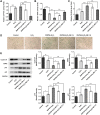Melatonin Alleviates Age-Associated Endothelial Injury of Atherosclerosis via Regulating Telomere Function
- PMID: 34924765
- PMCID: PMC8674670
- DOI: 10.2147/JIR.S329020
Melatonin Alleviates Age-Associated Endothelial Injury of Atherosclerosis via Regulating Telomere Function
Abstract
Background: Atherosclerosis is an aging-related disease, partly attributed to telomerase dysfunction. This study aims to investigate whether telomere dysfunction-related vascular aging is involved in the protection mechanism of melatonin (MLT) in atherosclerosis.
Methods: Young and aged ApoE-/- mice were used to establish atherosclerotic mice model. H&E staining and immunofluorescence assay were performed to detect endothelial cell injury and apoptosis. Inflammatory cytokines and oxidative stress-related factors were determined using corresponding commercial assay kits. Telomerase activity was detected by TRAP assay, and SA-β-gal staining was conducted to evaluate cellular senescence. HUVECs were treated with H2O2 for 1 h to induce senescence. Western blot was performed to measure protein expression.
Results: An obvious vascular endothelial injury, reflected by excessive production of inflammatory cytokines, elevated ROS, MDA and SOD levels, and more apoptotic endothelial cells, was found in atherosclerotic mice, especially in aged mice, which were then greatly suppressed by MLT. In addition, telomere dysfunction and senescence occurred in atherosclerosis, especially in aged mice, while MLT significantly alleviated the conditions. CYP1A1, one of the targeted genes of MLT, was verified to be upregulated in atherosclerotic mice but downregulated by MLT. Furthermore, H2O2 induced a senescence model in HUVECs, which was accompanied with a remarkably increased cell viability loss and apoptosis rate, and a downregulated telomerase activity of HUVECs, and this phenomenon was strengthened by RHPS4, an inhibitor of telomerase activity. However, MLT could partly abolish these changes in H2O2- and RHPS4-treated HUVECs, demonstrating that MLT alleviated vascular endothelial injury by regulating senescence and telomerase activity.
Conclusions: Collectively, this study provided evidence for the protective role of MLT in atherosclerosis through regulating telomere dysfunction-related vascular aging.
Keywords: atherosclerosis; melatonin; senescence; telomere; vascular aging.
© 2021 Xie et al.
Conflict of interest statement
The authors declare that they have no known competing financial interests or personal relationships that could have appeared to influence the work reported in this paper.
Figures





References
-
- Perk J, De Backer G, Gohlke H, et al. European Guidelines on cardiovascular disease prevention in clinical practice (version 2012). The Fifth Joint Task Force of the European Society of Cardiology and Other Societies on Cardiovascular Disease Prevention in Clinical Practice (constituted by representatives of nine societies and by invited experts). Eur Heart J. 2012;33(13):1635–1701. doi:10.1093/eurheartj/ehs092 - DOI - PubMed
LinkOut - more resources
Full Text Sources
Miscellaneous

